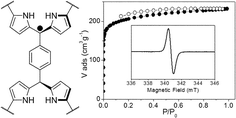A new family of paramagnetic microporous polymeric organic frameworks (POFs) has been developed through the co-polymerization of terephthalaldehyde and pyrrole, indole, and carbazole, respectively. These POFs are functionalized with stable unpaired electrons and electron paramagnetic resonance spectroscopy and pulsed ENDOR spectroscopy confirms their existence. The free radicals are produced in the early steps of polymerization and are responsible for their optical properties and the chemical adsorption properties of the POFs. The optical band gap of these materials ranges from 0.8 to 1.6 eV. The new POFs have spherical morphology and exhibit surface areas up to 777 m2 g−1 (Pyr-POF-1). Furthermore, Pyr-POF-1 displays the uptake of CO2 14% wt and C2H6 9% wt at 273 K/1 bar and H2 1.2% wt at 77 K/1 bar. The pyrrole based material (Pyr-POF-2) shows high capacity for CO2, 10% wt, under ambient conditions (298 K/1 bar) and the isosteric heat of CO2 adsorption of ∼34 kJ mol−1. The preparation of this new POF family is based on a very simple synthetic pathway and highlights the significance of terephthalaldehyde as a precursor for the synthesis of low cost functional porous polymers.

You have access to this article
 Please wait while we load your content...
Something went wrong. Try again?
Please wait while we load your content...
Something went wrong. Try again?


 Please wait while we load your content...
Please wait while we load your content...